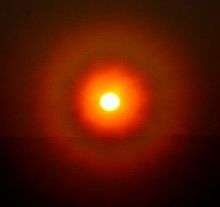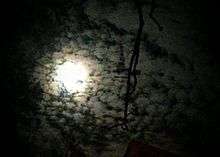Corona (optical phenomenon)


In meteorology, a corona (plural coronae) is an optical phenomenon produced by the diffraction of light from the Sun or the Moon (or, occasionally, bright stars or planets)[1] by individual small water droplets and sometimes tiny ice crystals of a cloud or on a foggy glass surface. In its full form, a corona consists of several concentric, pastel-colored rings around the celestial object and a central bright area called aureole. The aureole is often (especially in case of the Moon) the only visible part of the corona and has the appearance of a bluish-white disk which fades to reddish-brown towards the edge. The angular size of a corona depends on the diameters of the water droplets involved: Smaller droplets produce larger coronae. For the same reason, the corona is the most pronounced when the size of the droplets is most uniform. Coronae differ from halos in that the latter are formed by refraction (rather than diffraction) from comparatively large rather than small ice crystals.
See also
References
- ↑ Cowley, Les (2012). "Jupiter corona from Iran". Atmospheric Optics. Retrieved 2016-05-02.
External links
| Wikimedia Commons has media related to Corona. |
- Explanation and image gallery - Atmospheric Optics by Les Cowley
- Rings around the sun and moon: coronae and diffraction
- Corona from Fogged Eyeglasses
- Experimental simulations of pollen coronas
- The Corona

Gallery
 Forest Corona
Forest Corona Reflection of solar corona
Reflection of solar corona Solar Corona at Golden Gate Bridge
Solar Corona at Golden Gate Bridge Partial Corona at Golden Gate Bridge
Partial Corona at Golden Gate Bridge- Moon